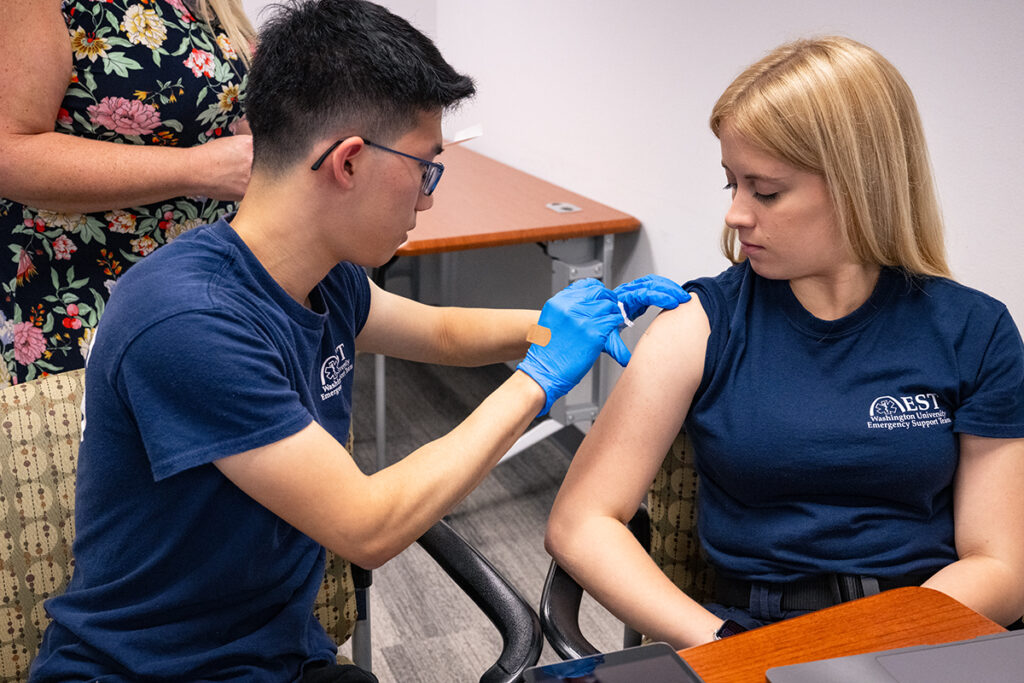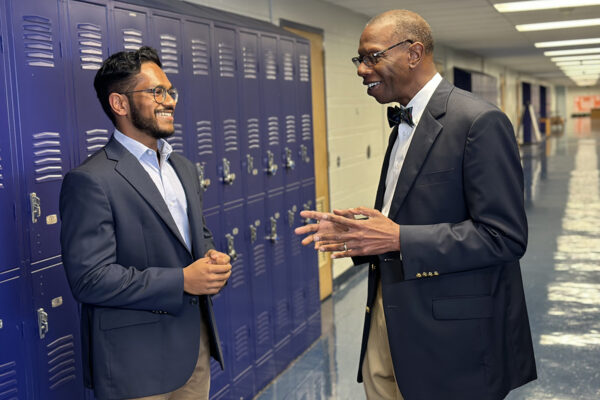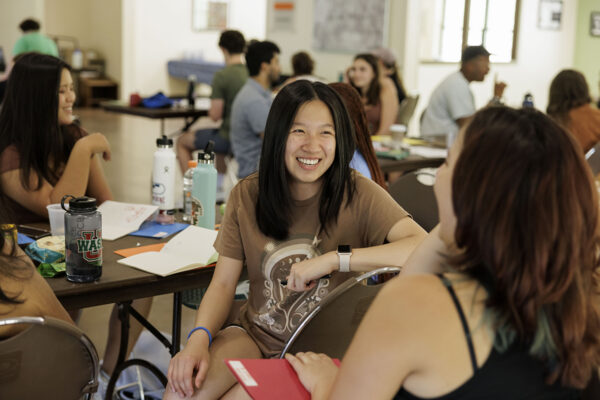It is 8:20 p.m. Tuesday and junior Annelise Molavi, a certified emergency medical technician for Washington University’s Emergency Support Team (EST), is dispatched to Lien Hall for a seizure.
She arrives with another EST tech and asks the roommate what’s going on. Did the patient hit his head when he fell on the floor? Has this happened before?
She then examines the student’s cervical spine while her tech takes his vitals. What’s your name?, she asks. No response. Can you squeeze my hand? Again, nothing.
Molavi proceeds with a rapid trauma assessment. She checks for bleeding from the head, rigidity in the stomach, discoloration in the pelvis, all the while scanning for deformities, contusions, abrasions, punctures, burns, tenderness, lacerations and swelling. She just finishes when the student seizes again.
She calls for an ambulance, directs the tech to cradle the patient’s head and clears the surrounding area of objects. Coming to, the patient can’t remember the day of the week, but he can tell Molavi his name is George and that he takes medication for seizures. She directs the tech to take his vitals again and asks more questions: Did he take his medication, does he feel tingling, has he eaten? Clayton paramedics arrive and Molavi exits, taking a deep breath as she closes the door.
“Wow. That was a great seizure mock,” George says as he pops off the floor.
George is not a real patient; he is junior Elijah Darden, assistant field director for Washington University’s Emergency Support Team (EST), a student group that provides free 24/7 emergency medical care on the Danforth Campus. And this was not a real medical emergency, but one of the dozens of mock trials Molavi must pass before she can be lead tech on a call.
“The training is intense, but it has to be,” said senior Cormac Nolan, EST field director. “We need to be prepared for anything we walk into.”

Breaking through barriers
If you ever have called the Washington University Police Department with a medical emergency, chances are EST arrived first to the scene. Clayton paramedics may have been dispatched, too. But EST, which owns an emergency vehicle, can get anywhere on the Danforth Campus within five minutes. EST’s 70 members, all equipped with radios and beepers, work in crews of three. They typically aren’t scheduled during class, but that’s not always possible. And those who work overnight shifts usually sleep in EST’s office in Lien House. “There are a couple of bunk beds and a nightstand where we keep the radios. When they go off, it’s like nothing you’ve ever heard before,” said Arden Pedraja, EST president. “I think we’ve all been conditioned to jump whenever we hear a buzz.”
Last year, EST responded to 400 calls ranging from cuts to anaphylaxis to chest pain to panic attacks. This being a college campus, EST also gets its fair share of alcohol-related calls. These cases can be both challenging and gratifying. Challenging because friends are sometimes slow to call WUPD for fear they will be disciplined. Gratifying because, as peers, EST techs can build trust quickly.
”We are in a unique position to break through that initial barrier and say, ‘We’re not here to lecture you or to judge you. No one here is in trouble. We just want to make sure that you are medically OK,” Nolan said, noting that EST techs are bound by health privacy laws just like any medical caregiver and that WashU offers medical amnesty. “That ability to relate one-on-one with a peer helps us build rapport, which is key for medical interventions to work. The Clayton paramedics are amazing, but it can be harder to break down that barrier and give help to a student who might not otherwise accept it when you don’t have that peer-to-peer relationship.”
Both Pedraja, of the Chicago suburbs, and Nolan, of the Cleveland suburbs, are majoring in neuroscience in Arts & Sciences and work at the School of Medicine. And both ultimately plan to attend medical school to be emergency medicine physicians. Indeed, most EST members are preparing for a career in health care. But while EST members are often pre-med, not all pre-med students are good candidates for EST.
“There are so many easier ways to get clinical experience than putting yourself through what it takes to be an upper-level tech.” said Nolan who, like Pedraja, devotes upwards of 50 hours a week to EST.
“Yeah, it’s a lot,” Pedraja added. “But we are all motivated to help this patient population that we know better than anybody else. And the time together has made us really close. We are a family. ”

Passion, drive and a bit of bravery
In addition to treating WashU students and staff, EST provides coverage crews for high-contact club sports rugby and Ultimate Frisbee and for events such as WILD. They also staff vaccine clinics and offer CPR training as well as active bystander training. Pedraja said EST also hopes to offer “Stop the Bleed” training in the future.
On this day, Elizabeth Fear and Tony O’Rourke of Habif Health & Wellness Center are teaching new techs how to administer the flu vaccine when Cheri LeBlanc, MD, executive director of the Habif Health & Wellness Center and EST’s adviser, stops in to say hello.
“You are providing such a great service for your fellow students,” LeBlanc told the students. “Thank you so much for all that you do.”
When LeBlanc first arrived a decade ago, she was surprised to learn that undergraduate students were treating their classmates.
“I was like, ‘Are they really trained?’” LeBlanc recalled. “But once I looked at their training — not just their EMT training but the additional training that is unique to this organization — I was so impressed. I would trust them to care for my own children. They have so much passion and so much drive.”
And a bit of bravery. After learning how to locate the injection site and engage the safety shield on the needle, sophomore Will Hou administered his very first shot, the flu vaccine to his partner Pedraja. She didn’t feel a thing as he applied the bandage.
“That went really great,” Hou said. “Now I’m ready for anything.”



